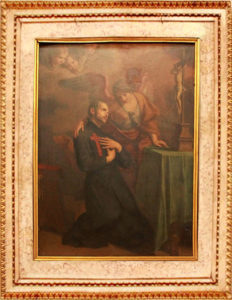 In January 1713, pope Clement XI assigned to the Camillians the Roman parish church of St. John of Malva in the neighbourhood of Trastevere. In February 1714, the Vicar General of the Order presented to the Congregation for the Regular Discipline a memorial in which he pointed out how they arranged to place four religious and two brothers in the new house. Now, however, the Order had decided to transfer the roman novitiate there, “in order to make the novices live more segregated from other religious” to guarantee a better service to the Church. The Congregation gave its approval, without prejudice to the suppression of the novitiate of Santa Maria in Trivio (near the Trevi Fountain).
In January 1713, pope Clement XI assigned to the Camillians the Roman parish church of St. John of Malva in the neighbourhood of Trastevere. In February 1714, the Vicar General of the Order presented to the Congregation for the Regular Discipline a memorial in which he pointed out how they arranged to place four religious and two brothers in the new house. Now, however, the Order had decided to transfer the roman novitiate there, “in order to make the novices live more segregated from other religious” to guarantee a better service to the Church. The Congregation gave its approval, without prejudice to the suppression of the novitiate of Santa Maria in Trivio (near the Trevi Fountain).
The church is of ancient origin. We already find in the catalogues of the churches in Rome of 1119 with the name of St. John at Gianicolo which changed the name to St. John of Malva perhaps due to the dense presence of mallow plants in that area, or due to the corruption of the term “mica aura”. The house at St. John of Malva was opened by Camillians in 1714. Due to a violent earthquake, it was destroyed in 1811. In 1842, Fr. Luigi Togni managed to get a large sum from Duchess Anna Londei Grazioli to be used for the reconstruction of the whole complex from the foundations. The Duchess is remembered in an inscription placed in memory of the restoration of the church, which was reopened in 1851.
Gaetano Lapis, St. Camillus, comforted by the angel, has the vision of the Crucifix, 1763, oil painting on canvas, 220x144cm, church of St. John of Malva, Rome.
Gaetano Lapis, a student of Conca, made in 1763 the altarpiece for the chapel of the saint (church of St. John of Malva, Rome), where the model of the vision of the Crucifix merges with that of the comfort of the angel. The result is a work that adapts to the patterns in use with sobriety and sentimentality.
Also, the church of St. John of Malva is listed among the places of Camillians, who lived there until 1870 to assist the sick and the sick of the parishes nearby Santa Maria in Trastevere and St. Dorotea.















Camillians on Facebook
Camillians on Twitter
Camillians on Instagram